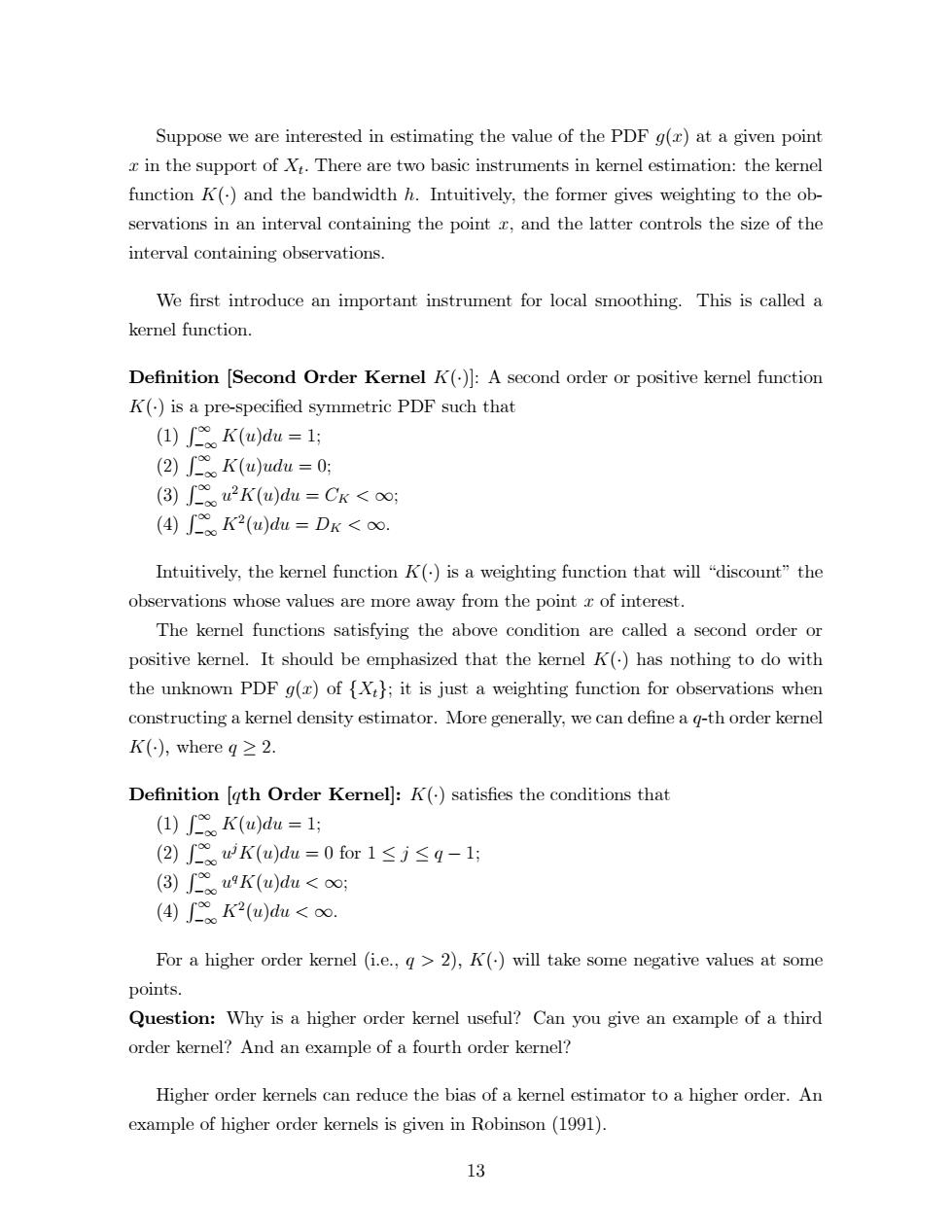正在加载图片...

Suppose we are interested in estimating the value of the PDF g(r)at a given point x in the support of Xt.There are two basic instruments in kernel estimation:the kernel function K()and the bandwidth h.Intuitively,the former gives weighting to the ob- servations in an interval containing the point and the latter controls the size of the interval containing observations. We first introduce an important instrument for local smoothing.This is called a kernel function. Definition [Second Order Kernel K()]:A second order or positive kernel function K()is a pre-specified symmetric PDF such that (1)∫eK(u)du=1: (2)K(u)udu=O; (3K(u)du=CK<; (4∫K2(u)dhu=DK<o. Intuitively,the kernel function K()is a weighting function that will "discount"the observations whose values are more away from the point r of interest. The kernel functions satisfying the above condition are called a second order or positive kernel.It should be emphasized that the kernel K()has nothing to do with the unknown PDF g(z)of [Xt;it is just a weighting function for observations when constructing a kernel density estimator.More generally,we can define a g-th order kernel K(),where q≥2. Definition [gth Order Kernel]:K()satisfies the conditions that (1)K(u)du=1; (2)∫wK(u)du=0for1≤j≤9-1 (3)uK(u)du<oo; (④)∫K2(u)du<oo. For a higher order kernel (i.e.,g>2),K()will take some negative values at some points. Question:Why is a higher order kernel useful?Can you give an example of a third order kernel?And an example of a fourth order kernel? Higher order kernels can reduce the bias of a kernel estimator to a higher order.An example of higher order kernels is given in Robinson (1991). 13Suppose we are interested in estimating the value of the PDF g(x) at a given point x in the support of Xt : There are two basic instruments in kernel estimation: the kernel function K() and the bandwidth h. Intuitively, the former gives weighting to the observations in an interval containing the point x, and the latter controls the size of the interval containing observations. We Örst introduce an important instrument for local smoothing. This is called a kernel function. DeÖnition [Second Order Kernel K()]: A second order or positive kernel function K() is a pre-speciÖed symmetric PDF such that (1) R 1 1 K(u)du = 1; (2) R 1 1 K(u)udu = 0; (3) R 1 1 u 2K(u)du = CK < 1; (4) R 1 1 K2 (u)du = DK < 1: Intuitively, the kernel function K() is a weighting function that will ìdiscountîthe observations whose values are more away from the point x of interest. The kernel functions satisfying the above condition are called a second order or positive kernel. It should be emphasized that the kernel K() has nothing to do with the unknown PDF g(x) of fXtg; it is just a weighting function for observations when constructing a kernel density estimator. More generally, we can deÖne a q-th order kernel K(); where q 2: DeÖnition [qth Order Kernel]: K() satisÖes the conditions that (1) R 1 1 K(u)du = 1; (2) R 1 1 u jK(u)du = 0 for 1 j q 1; (3) R 1 1 u qK(u)du < 1; (4) R 1 1 K2 (u)du < 1: For a higher order kernel (i.e., q > 2); K() will take some negative values at some points. Question: Why is a higher order kernel useful? Can you give an example of a third order kernel? And an example of a fourth order kernel? Higher order kernels can reduce the bias of a kernel estimator to a higher order. An example of higher order kernels is given in Robinson (1991). 13